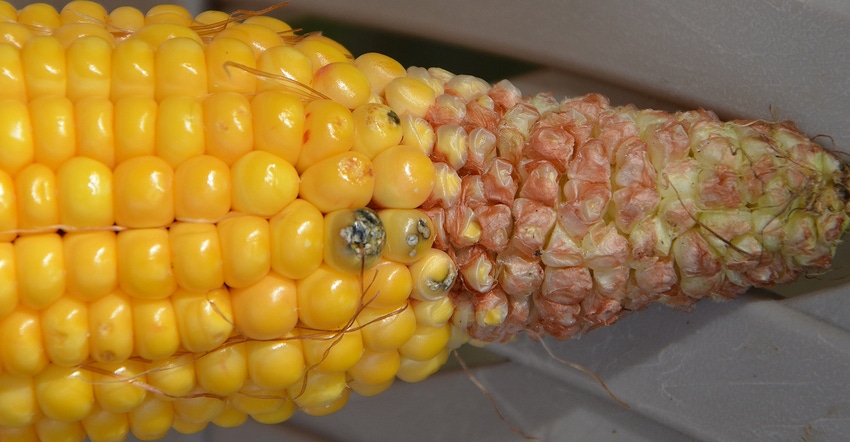
One of the first things Dave Nanda did in the Corn Watch ’19 field this year was set up a specific place to monitor the crop during the season. He marked off 1/1,000 of an acre and checks that location each time he visits the field. He marked it with GPS to help him locate it.
Nanda, director of genetics for Seed Genetics-Direct, Jeffersonville, Ohio, visits the Corn Watch ’19 field in central Indiana regularly. Seed Genetics-Direct sponsors Corn Watch ’19.
“Returning to the same spot each time gives us a chance to see how plants develop and change with time,” Nanda says. The field was planted May 28 and pollinated during the last week of July.
Here are five things Nanda will be monitoring in both rows on either side of the imaginary line representing 1/1,000 of an acre:
1. Aborted kernels. These usually are more common on the tips of ears. Plants try to make as many “babies” as possible, Nanda says. If stress sets in after pollination, the tip kernels are the first sacrificed by plants.
2. Kernel depth. Weather conditions during grain fill will have a big impact on how kernels fill out. There is a genetic component to kernel depth and cob size, but it also depends upon weather, Nanda insists. When conditions are favorable, plants continue packing starch into kernels as long as they can.
3. Tightness of husks. How many husks surround the ear and how tight they are could be an important factor this year, Nanda says. It’s also related to genetics. Ears with thinner husks may allow corn to dry down a bit faster. With a late-maturing crop, drydown rate and moisture content become big factors.
4. Ear rots. Nanda likes to preserve the rows he’s watching, so he may go just outside his designated area and pull back some husks. He will look for signs of mold. The color and pattern of the mold — whether it starts at the tip or butt of the ear — can indicate what type of mold is present.
He measures prevalence. Is there just an ear here and there, or are numerous ears already infected with mold? If numerous ears show signs, that field may need to be marked for early harvest, Nanda says. “Early harvest” may be relative this year, and may require weighing extra drying costs versus allowing mold to continue to develop in the field. Some of these molds produce mycotoxins, which can harm livestock when fed, and which may result in dockage or rejection at the elevator.
5. Stalk strength. Nanda will walk down the row, outside the area he marked off to watch, and push on 100 stalks in a row. He wants to see how many don’t snap back. “If five stay bent out of 100, we already have 5% lodging,” Nanda says. “You’re back to weighing the cost of drying grain versus potential losses due to lost ears because of lodging.”
Even in late July, Nanda noticed some elbowing because of limited rooting and lack of adequate brace roots. He expects root lodging will be an issue.
About the Author(s)
You May Also Like




